New Mexico
| |
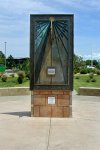 |
Albuquerque |
New Mexico |
USA |
Vertical Dial |
Dial 567 |
| A vertical "Icarus Sundial" of bronze, copper and ceramic 86 inch high x 48 inch wide on a 30 inch high pedestal in front of the Explora science museum. The gnomon depicts Icarus falling; the back side depicts Icarus ascending toward the sun. The pedestal is placed within a 20 foot concrete circle showing a labyrinth defined by a sandblasted path of feathers. |
| |
| |
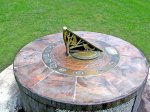 |
Albuquerque |
New Mexico |
USA |
Horizontal Dial |
Dial 669 |
| A 36 inch diameter brass and copper horizontal sundial with a gnomon depicting a bird standing and a bird in flight. The bird motif reminds of "The Bird of Time has but a little way to fly--and Lo! the bird is on the Wing" by Omar Khayyam.
The gnomon is buttressed for strength and includes a brass ball at the top as a safety feature in light of a nearby middle school. |
| |
| |
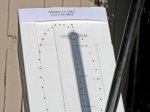 |
Albuquerque |
New Mexico |
USA |
Sun Alignment |
Dial 723 |
| An 8x36 inch polar noon meridian dial of wood and steel pipe. The dial face is inclined at the latitude angle and the shadow-casting 36-inch gnomon pole is perpendicular to the dial face, pointing at the local meridian on the celestial equator. The gnomon pole shadow shows the declination of the sun, with the shadow extending below the gnomon in spring and summer, and above the gnomon in fall and winter. Short rods at the tip of the gnomon cast a cross-shaped shadow on the dial face, marking the date on the nail head analemma on the dial face. At local noon the gnomon shadow is vertical; the face and gnomon size are selected to allow the shadow to always fall on the dial face at noon throughout the year. On the equinoxes, the cross shadow bisects the gnomon base.
This dial is on private property but may be seen from the public sidewalk. For closer inspection, the owner may be contacted. |
| |
| |
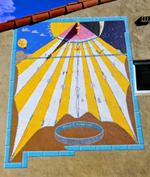 |
Albuquerque |
New Mexico |
USA |
Vertical Dial |
Dial 921 |
| This painted vertical dial is 10 x 11 feet, covering a vast expanse of south facing wall. The dial has a strong New Mexico theme using bright colors, and many personal elements. There is a road runner, hot air balloon, a lunar footprint (centered at 2:18 (clock time) on July 20th 1969, the minute they landed). There is a red, white & blue star at the 11th hour of the 11th day of the 11th month for Veterans Day. In the night exposure of the sundial the star Polaris is just above the gnomon, as it should always be. All the little embedded details in the sundial are explained on the ‘Details’ tab of the website link below. |
| |
| |
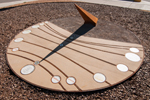 |
Alburquerque |
New Mexico |
USA |
Horizontal Dial |
Dial 854 |
| This was a unique horizontal sundial designed for the Nob Hill Main Street program, where the sundial anchored the southeast corner of the Nob Hill Community Garden. Created several years ago by Mike Heighway and Mira Rose, Mike explained, "The purpose of the Nob Hill Sundial is to act as an interactive gardener’s guide. It works on an annual cycle by casting a shadow from a large center piece (the gnomon) onto a concrete plate with embedded steel [diurnal] bands and porcelain tiles that describe that month’s gardening activities." The dial itself was about 10 feet in diameter with an metal, rust-colored gnomon. The sundial is designed around the summer and winter solstice, since these are ultimately the times of year when the sun is either at its highest or lowest point in the noon sky. Each horizontal band connects to two tiles; one side for months approaching the summer solstice, and the other for months approaching the winter solstice. The tiles instruct people what monthly activities to do in the garden. |
| |
| |
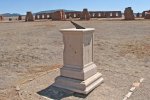 |
Fort Union |
New Mexico |
USA |
Compound Dial |
Dial 393 |
| A 2 foot square stone horizontal dial on a four foot high stone pedestal with vertical dials on its faces. This dial has been removed, replaced and relocated several times. The original gnomon was lost and replaced with an incorrect 45° gnomon, which has been replaced again with a steel gnomon that appears to be at slightly less than the correct latitude angle. All vertical dial gnomons are missing. The dial and a nearby inscribed stone are on the grounds of the Third Fort Union (1863-1891). The stone dial surfaces are worn from weather, but the Arabic hour numerals are still visible. |
| |
| |
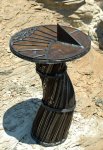 |
Gallup |
New Mexico |
USA |
Horizontal Dial |
Dial 568 |
| An 18 inch diameter horizontal dial of welded steel with a naturally weathered rusty brown finish. The hour lines are corrected for longitude and summer and winter solstice lines are shown. |
| |
| |
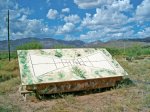 |
Gila |
New Mexico |
USA |
Polar Dial |
Dial 541 |
| An 8x4 foot painted plywood polar dial. Contact owner M. Cuff for access. |
| |
| |
 |
Jemez Springs |
New Mexico |
USA |
Analemmatic Dial |
Dial 552 |
| Analemmatic dial of cast concrete 6m E-W by 2.2m N-S |
| |
| |
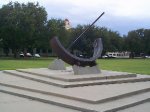 |
Las Cruces |
New Mexico |
USA |
Equatorial Dial |
Dial 452 |
| A large equatorial dial with steel gnomon. The massive dial is set simply on a set of tiered platforms. The inner tiers are rotated from the outer to align to the cardinal points. Elsie Raye Rigney Carr and Dr. Jesse Lawrence Carr gave the dial to the university in 1975 in memory of Raye Hines Rigney, Class of 1911. |
| |
| |
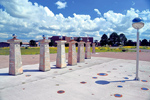 |
Magdalena |
New Mexico |
USA |
Obelisk or Vertical Gnomon |
Dial 981 |
| This vertical gnomon sundial sitting on a 46-by-35-foot concrete slab was constructed using concrete piers of a solar mapping radio telescope array that Robert Bracewell originally built near the Stanford University campus. The array was abandon in the 1980's. The 10 piers were moved to the VLA in 2013 and arranged as a vertical gnomonic dial. NASA: "As for most sundials the shadow cast by the central gnomon follows markers that show the solar time of day, along with solstices and equinoxes. But markers on the [Bracewell] radio sundial are also laid out according to local sidereal time. They show the position of the invisible radio shadows of three bright radio sources in Earth's sky, supernova remnant Cassiopeia A, active galaxy Cygnus A, and active galaxy Centaurus A." |
| |
| |
|
Roswell |
New Mexico |
USA |
Horizontal Dial |
Dial 490 |
| A beautiful bronze sundial sits on a pillar of rough marble. It was given to the Library by the Roswell Womens Club at the turn of the 20th century. Unfortunately the dial is damaged, but the Roswell Womans Club is searching for someone to repair the dial. |
| |
| |
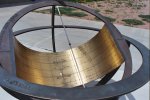 |
Sacramento Peak |
New Mexico |
USA |
Cylindrical Dial |
Dial 317 |
| The bronze cylindrical dial is 5-foot in diameter. The dial reads time and date from a rod gnomon cast onto an engraved, equatorial band. The dial shows date bands and solar time corrected for longitude (3 min 17s west of the 105 degree meridian). The dial is accurate to about one minute. At the noon hour line is an analemma showing the correction to mean time. The armillary sphere was designed and built by observatory staff members Dr. Don Neidig, Scott Gregory, and Mitchell Davis. |
| |
| |
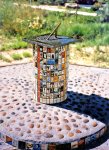 |
Taos |
New Mexico |
USA |
Horizontal Dial |
Dial 493 |
| A copper and bronze horizontal dial about 15 x 15 inches. The dial was built by the Rocky Mountain Youth Corp, an organization the helps direct the energies of "at risk" youth. Base of dial is clad with 2x4 inch glazed tiles made by all the 5th graders in town. There is a compass rose around the base and on dedication day, an area of wet cement was available those present to make an inscription or hand print. |
| |